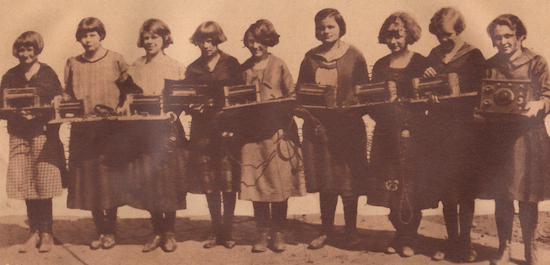Girls in Chicago show off radio sets they’ve built (July 1924 Radio News magazine)

Radio is for boys only. No girls allowed. Or at least that was the message from so many young men at the dawn of the medium.
There was a sense of betrayal by many young men in the early 1920s that radio was no longer their exclusive domain. Girls were rushing in and getting their cooties all over everything. The magazines of the early 1920s that had once catered to the “wireless amateur” as they were known began appealing to a broader base. No longer was the radio magazine implicitly sold as for men and boys by excluding women from its pages as so many did in the late 1910s. By 1922 women and girls were starting to be featured in many radio magazines as competent tech nerds who could hold their own with any man.
The July 1924 issue of Radio News ran the photo above and explained: “The girl pupils of one of Chicago’s public schools would not let the boys outdo them. Hence a contest was held for the making of radio sets, and prizes were offered. The girls have shown superior workmanship and attracted the attention of local experts. The above photo shows some of the prize winning sets and their owners.”
As Richard Butsch notes in his 1998 paper on gender and radio technology in the 1920s, the predominantly male audience of Radio News magazine was scandalized by the perceived feminization of its pages.
A letter to the editor in the November 1922 issue of Radio News:
… in the editorial of the first issue [July, 1919] you stated that the magazine was for and by the AMATEUR, and you signed off H. Gernsback — your editor. The issue of August, 1922 is nothing more than the average broadcast magazine, great numbers of which have recently sprung up, and you signed the editorial with a plain H. Gernsback.
The first issue of Radio News teemed over with AMATEUR, AMATEUR, and AMATEUR… Just try and count the amateur articles in last August’s issue.
And then alas came along the broadcast craze. The word AMATEUR, so profusely expounded in the first dozen issues, is absolutely left flat and his place is filled by the young chap who can only hear noises with his ‘steen’ step amplifier, or the kid whose crystal set doesn’t function properly. Of course, I realize it is more profitable to cater to the broadcast fiends from a financial standpoint, but don’t lose sight of the fact that it was the now apparently forgotten AMATEUR who originally put the magazine on its feet.
… if you canned those silly [fiction] stories and the articles on scarf-pin radio sets you would have room to admit some of the amateur stuff you were so glad to start with.
Reference to fiction stories and scarf-pin radio sets was a thinly-veiled swipe at women, and as Butsch notes, “[the editor’s] retreat from from a purely technical format was seen as an especially treacherous betrayal of his own followers’ faith in masculine technological mastery and contribution to the world.”
An advertisement for a Unidyne radio set in the July 1924 Radio News magazine [Novak Archive]

While the wireless magazines of the late 1910s (back when radio technology was used as a point-to-point communication rather than broadcast) suffered the wrath of angry young men, other magazines like Radio Broadcast, Radio Age and Radio World (all started in 1922) were more open to women from the start.
Butsch notes that Radio World featured many women in its pages from 1922 until 1924:
It included cartoons, many pictures of radio and cabinets in domestic settings, advice on how to choose a set for the parlor and many pieces on women. The magazine from its inception in 1922 to about mid-1924 gave marked attention to women. Pictures, stories and cartoons presented images of women in control of this new technology. The predominant message was one of women successfully using and enjoying radio. Numerous pictures showed women operating radios, for radio telegraphy as well as broadcast listening. A woman in New York was pictured playing chess via radio telephone with a female friend in Chicago. One cover featured the first woman graduate of a radio school.
But by mid-1924 something had changed. The pages of Radio World no longer showed women at the helm mastering technology but rather as set-pieces. The cover design of Radio World was suddenly featuring “young women in bathing suits, or dancing, legs exposed, while listening to radio.” The push-back from many corners of the male radio community had seemed to work.
Today the tech world grapples with its own gender problems. Women are under-represented not only in the major tech company boardrooms and Silicon Valley start-ups but also in the pages of tech’s leading culture magazines. We’ve undoubtedly made some progress since the 1920s, but we still have quite a ways to go.





